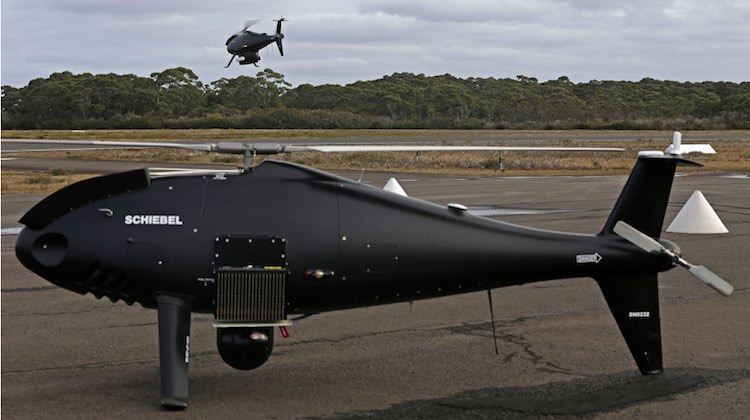
Schiebel program manager Fabian Knechtl says the first of its heavy fuel powered CAMCOPTER S-100 unmanned aerial vehicles (UAV) for the Royal Australian Navy (RAN) is scheduled to be delivered by November.
The Department of Defence signed a contract with Schiebel Group for the supply of Camcopter S-100 UAVs to meet the RAN’s interim vertical takeoff and landing (VTOL) unmanned aerial system (UAS) requirement in December 2016. It also included three years of support services.
Further, the contract fulfilled a request for tender (RFT) for Navy Minor Project (NMP) 1942, which sought to procure a “proven” VTOL Maritime Tactical Unmanned Aircraft System – Interim Capability (MTUAS-IC) and associated engineering and logistics support for the Navy.
Knechtl said the first S-100 would shortly be ready for factory acceptance by the RAN, with delivery to HMAS Albatross at Nowra expected in November.
“Within the next three years they will really validate and verify what they can do with a rotary wing VTOL system,” Knechtl said at PACIFIC 2017 on Thursday.
Featuring a carbon fibre and titanium fuselage, the S-100 has a maximum takeoff weight of 200kg and a maximum payload capacity of 50kg, according to the Schiebel website. It has a maximum speed of about 130kt and is powered by a 50hp rotary engine.
The aircraft has beyond line-of-sight capability out to 200km. Able to fly fully autonomously, it can be operated from a pilot control unit with missions planned and controlled via a simple point-and-click graphical user interface. High-definition payload imagery is transmitted to the control station in real time.
Knechtl said the RAN would be the launch operator of its heavy fuel version of the S-100.
Schiebel has replaced the Diamond piston engine on previous versions with a two-disc rotary engine that was sourced from a British supplier and modified in-house. The engines will take JP-5, a high flash point fuel that is increasingly the requirement now for navies around the world.
“Our information on our closest competitors, other rotary VTOL systems, is they claim they have a heavy fuel engine but they are not running and flying on JP-5,” Knechtl said.
“They are flying on Jet A1, which is a diesel or kerosene. This is not what Navy wants to do.
“It’s very nice to say you have a heavy fuel or diesel engine, but that doesn’t mean you have a JP-5 engine. This is the champions league of heavy fuel.”
The imminent arrival of the S-100 at Nowra would extend Schiebel’s work with the Navy that stretched back to 2015, when the aircraft was involved in some demonstrations as part of the RAN’s unmanned aircraft system development unit.
Also, the Austria-based Schiebel has proposed the CAMCOPTER S-100 UAV in its response to a request for information (RFI) from Defence’s Capability Acquisition and Sustainment Group (CASG) for a Maritime Tactical Unmanned Air System (MTUAS) to be operated from the Royal Australian Navy’s (RAN) forthcoming Offshore Patrol Vessels (OPVs).
Other contenders for the requirement were likely to include the UMS Skeldar V-200 and Northrop Grumman MQ-8 Fire Scout.
Meanwhile, it was understood Schiebel was also considering the development of a larger “bigger brother” version of the S-100 in response to market demand. Any larger UAV may be suitable for the Future Frigates program.
There were an estimated 100 S-100 aircraft flying with various operators around the world, with Schiebel regarded as the market leader in its class.
In March, an S-100 crashed inside the Beecroft Air Weapons Range at Jervis Bay in NSW, while conducting flying conversion training for RAN personnel. Schiebel Aircraft was the contracted operator and owner of the aircraft involved.
Both the RAN and the manufacturer were investigating the incident and Knechtl said many lessons have already been learned.
Schiebel was part of the Queensland state government’s Department of State Development stand at PACIFIC 2017, which served to highlight the company’s commitment to involving local industry in its Australian operations.
Its Australian representative is Brisbane-based Unmanned Systems Australia.
Knechtl said Australian firms have been used to supply certain modules to its Camcopter system to be used by the RAN.
“We know it is very important, not only from a political aspect, that if you want to be in the game you must create jobs and team up with Australian companies,” Knechtl said.
“We are really exploring every option as to what will be best.”












